-
Content Count
102 -
Joined
-
Last visited
Content Type
Profiles
Forums
Gallery
Articles
Gun Dealer's and Fieldsports Shop's
Reloading Room
Blogs
Calendar
Store
Classifieds
Posts posted by swamp thang
-
-
I sell catfish fingerlings, when they are six weeks old, and about an inch long, Sniffer. My hatchery creates a reproductively sterile but fast growing cross-breed of two African catfish, the Heterobranchus logifilis, which can grow quite big in the wild, and the Clarias "walking" catfish, which reaches a smaller adult size. Those fingerlings are raised by local farmers for 4 to 6 months when they reach a couple of kilos in size, and then sold by weight in markets here. Both parent stock and their fast-growth offspring are air-breathing catfish which are generally sold alive by the fish farmers, which is important in the Third World where there isn't constant electricity much of the time, to power fridges and freezers.
One of these days I'd like to see how European Wells catfish fare in the endless summer weather here, where they can feed and grow year round with no hibernation period like there is during those European winters. I think they'd grow very fast, perhaps even faster than the local species here. There's a Wells hatchery in Austria that I hope to buy some fry from one day, after I get the import and export permits sorted.
The ponds down by the river are where I keep the parent broodstock catfish, since they don't fare well in concrete tanks, and the camera that caught that deer at dawn was actually set up to photograph a man who had been poaching my broodstock at night for a long time. Got the poacher on film a few times, and then the night guards scared him off recently, so hopefully he will stay away from my prized broodstock now.
-
I'm in west Africa. The website mods know exactly where of course, but just in case any government officials from this neck of the woods are listening in, I can't be too specific, given the way firearm permits get revoked here from time to time, and hunting weapons "confiscated", as a prelude to, ahem, re-distribution of said weapons to more "deserving" owners.
-
 1
1
-
-
Hello Jonah, The camera is the Covert Black 60 trailcam, one of the new generation of "black flash" infra-red cameras whose flash is not visible to the human eye. This camera really comes into its own at night, and has the brightest "invisible" flash on the market right now, which really lights up the night better than most other models on the market.
The bushbuck are kept in a really small area of maybe an acre at best, surrounded by 8-foot high chain-link fence. I keep them mostly for visitors and schools to look at, but the bucks get terrirotial during their rut, and the dominant one sometimes gores lesser males, which then go in the pot, after the injured area is cut out, since I have no tranquillizer gear to capture them for medical care.
The number of bushbuck seems to have stabilized at between 25 and 30, with most of them does and fawns. I also have about 20 smaller duiker antelope, which are light grey in color and stand just a foot tall, but they didn't show up for the group picture when I set the camera up. I'll try and post a shot of one later.
There are no predators besides humans here, with most of the remaining wildlife under extreme hunting pressure year round. Visitors who hunt have been the most impressed with this small herd of mine, since they only get to see animals running full throttle during a hunt, and never calmly wandering about like these domesticated ones do here.
-
They really are stunning animals, and look in very good condition as well: you must be doing something right! How did you come up with the pre-soaked beans supplement? Was it trial and error or what?
Hello Skycat,
When I first started out trying to raise bushbuck in captivity with a few orphaned fawns some years back, I was fairly confident from my years of hunting them that I knew all the varieties of foliage that they eat, but I found out that the leaves and vines that were being brought in for them were still lacking in some key nutrient that I couldn't put my finger on.
Finally a man who kept goats showed up, and noting how skinny the bushbuck in the pen were back then, suggested I try feeding them raw beans like he fed his goats, but only if the beans had been soaked for 3 to 4 hours beforehand, during which time they would swell up, and increase somewhat in volume. The goat farmer cautioned that any shorter of a soak than 3 hours, and the beans would swell up after being eaten by the animals, bloating them to where they could even die from it.
Literally within weeks of adding the pre-soaked beans and cattle salt-lick blocks to their diet, the bushbuck filled out, looked way better, and began to breed, which they hadn't done at all before the diet change. That extra protein from the beans made a world of difference, and the animals have thrived ever since.
I had to add this last picture. This one seems to have just learnt what my home-made sign in the background is about.
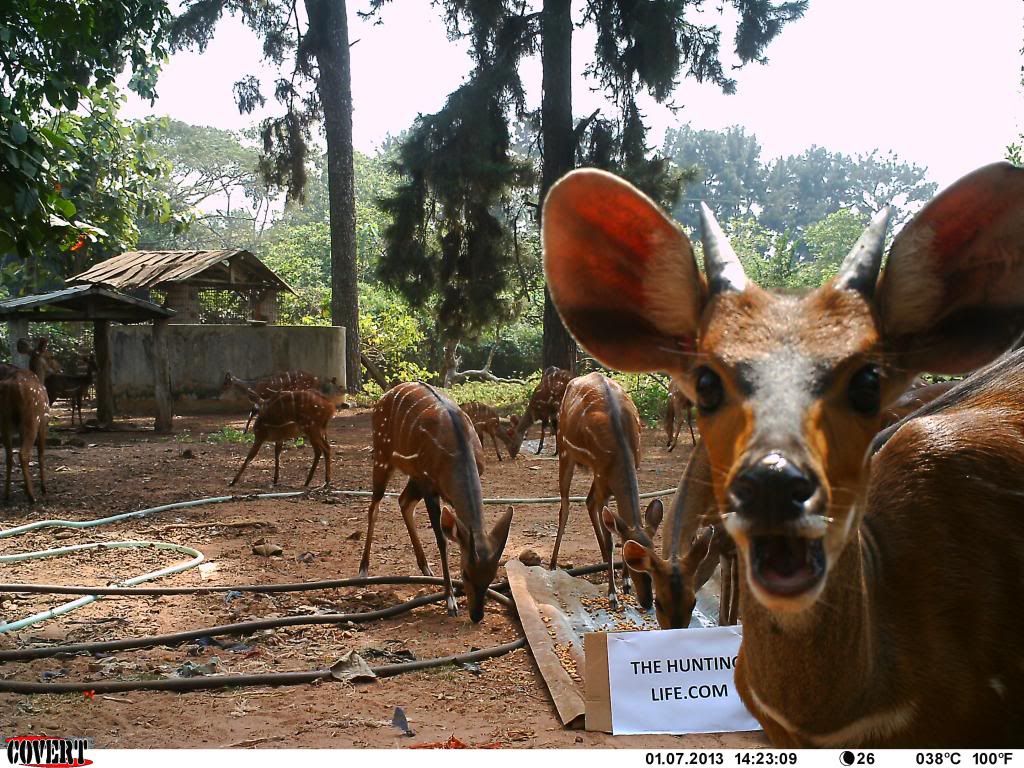
-
 1
1
-
-
The bushbuck herd in the pen out back aren't anywhere near tame, so the only way I was able to get this group closeup was to put a trail-camera out when they gather for lunch.
Without this addition of pre-soaked beans to supplement their diet of leaves, these animals just waste away and won't breed at all. They also get cattle salt-lick blocks for their minerals.
Almost all of these were born in captivity, though I do buy the odd fawn from local hunters who would otherwise feed them to their hunting dogs, and those youngsters get bottle-fed till they can eat greens.
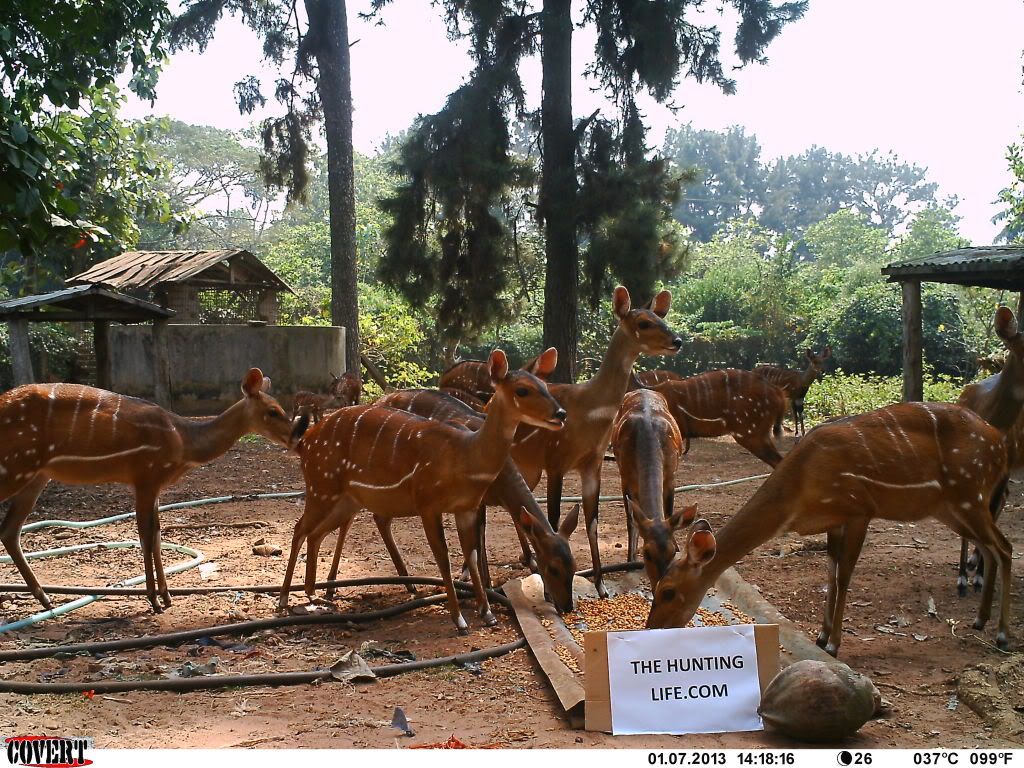
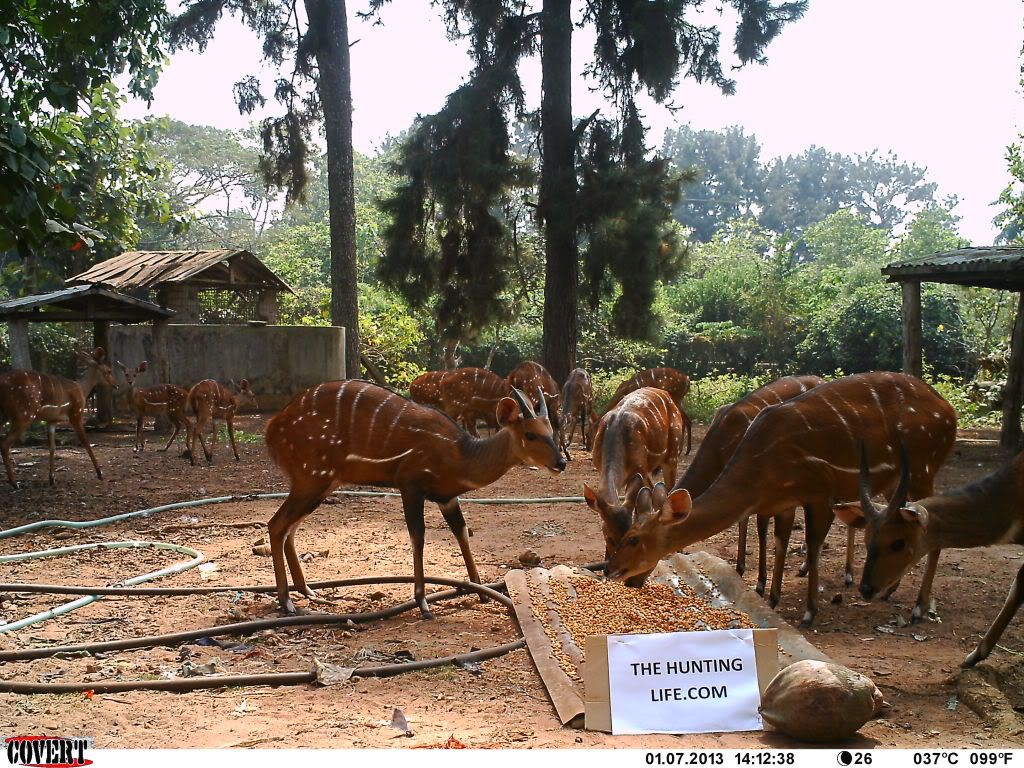
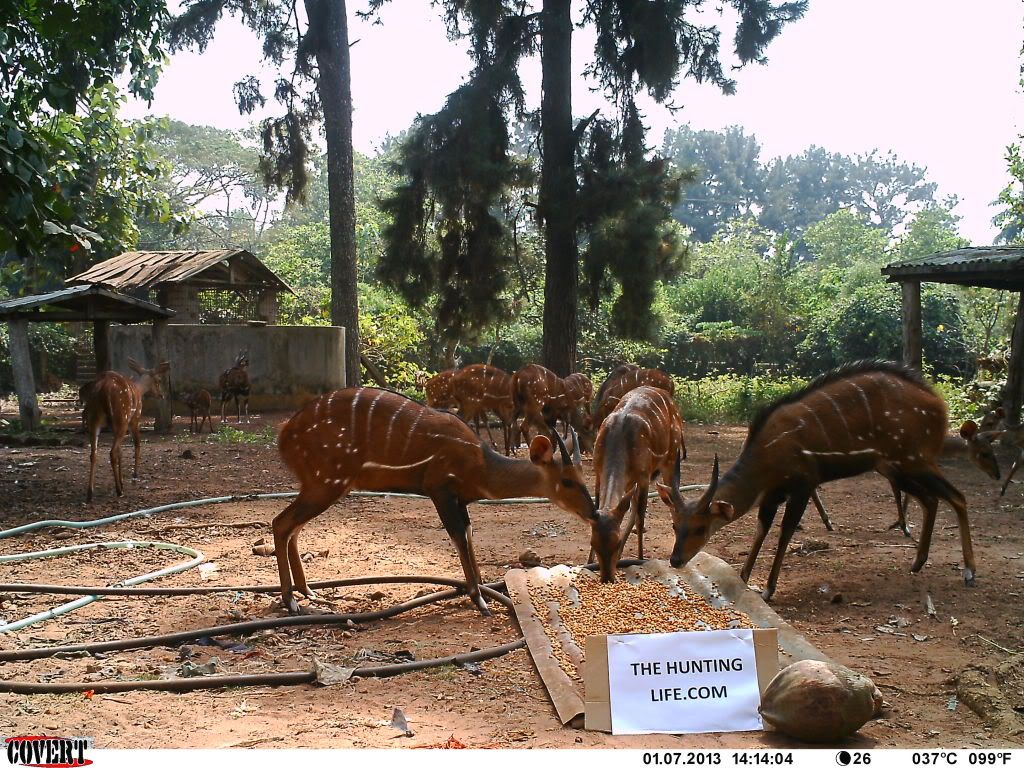
-
 1
1
-
-
Beware the rampaging deer, for he hath no fear, when he's had a beer.
The reactions of those pedestrians was nice to watch. They just glanced back over their shoulders, as if they were expecting a procession of deer to follow the first one down the street.
-
Hello Pledgey, the very best website I have found for trail cameras on the internet is called "chasing game.com". That website is frequented by a lot of very experienced trail cam users from all over the world, and some of those guys have up to twenty cameras set up on their land.
The "Chasing Game.com" website carries detailed user test results from all the latest trail cameras on the market, plus some of the most amazing collections of wildlife pictures taken with trail cameras owned by subscribers to that website.
From my limited experience with trail cameras, the ones to avoid are generally those made by Bushnel. They don't last long, and there are many, many customer complaints about them. The very best trail camera that I have found for my security surveillance so far has been the Covert Black 60 camera, which has a "black flash" that is invisble to the human eye, but which lights up the night like no other camera, for clear photos on pitch black nights.
The date and time stamp is pretty much standard on most trail cameras on the market, and that feature really helped me when it came time to lay ambush for the gentleman that had been helping himself to my 7-year old catfish brood-stock almost nightly for a good while. The catfish poacher's last visit was a short one, because he had to flee when the guard let fly over his head with a blast of bird-shot.
-
Just seen the Muntjac picture. Looks a lot like an African Duiker. Muntjacs are supposed to be Asian originally, I read somewhere.
-
Ok I managed to get a couple of shots of my captive Sitatunga, named Swampy by my eight-year old. He is about half grown now, comparing his horns to those of the one I caught on film by the river-side.
Very nervous animal this one, even though he will walk up to people he knows. We had to suspend re-roofing a shed nearby, because he went haywire with the carpenters noise, and wouldn't eat for a week.
Here he is snacking on his favourite treat - Moringa olifera leaves.
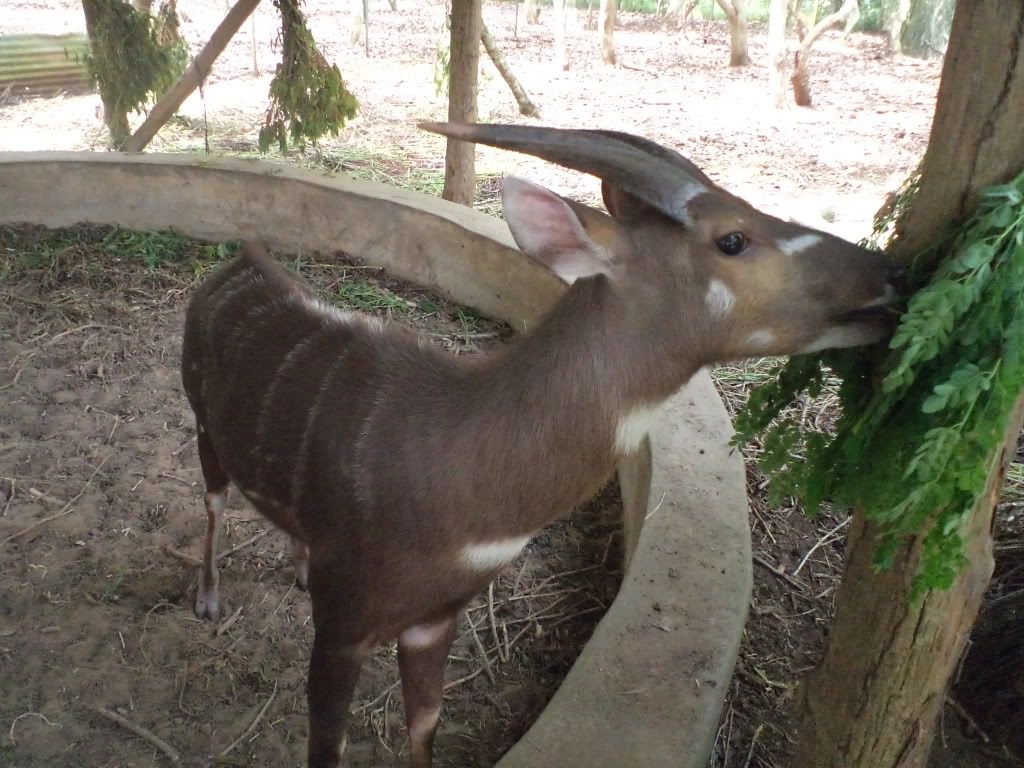
Here is another shot. I was about to crouch down to get a petter perspective, but his hackles went up, and he moved in for a head-butting joust, which I would have lost for sure, so I stood back up and took this slightly blurred picture.
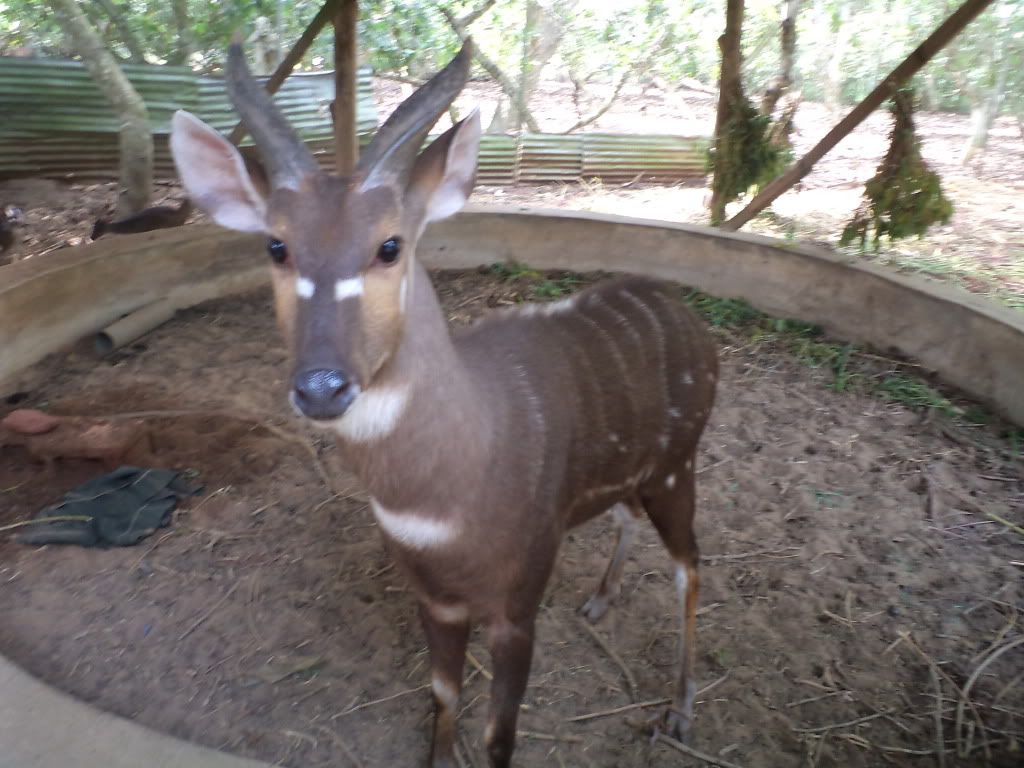
-
 2
2
-
-
The forest runs in a narrow ribbon along the banks of a stream, Skycat, and it is there that these animals find refuge from year- round unrestricted hunting pressure. The bushbuck (Tragelaphus scriptus) is actually a grassland species, but this small group have adapted to skirting the edges of the swamp behind my catfish ponds, where the hunters and their dogs don't go due to difficult terrain.
The far more rare and stealthy Sitatunga ( Tragelpahus spekei gratus), shown in my earlier night pictures, is a slightly larger cousin of the bushbuck, and is a purely swamp-dwelling antelope, with elongated hooves for walking in soft mud. Sitatungas are expert swimmers, but often they silently submerge in the murk when they get spooked, vanishing without a foot-fall.
I'll see if I can find a good picture to post here of my tame Sitatunga juvenile buck in a pen out back , whom I have trained to trot over to claim rewards of favourite leaves. The captive-raised Sitatunga, sold to me as a fawn by a trapper, is a fair bit younger and smaller than the one in the above pictures, but he is way bigger than a mature bushbuck already, at a little over 18 months old now.
-
 1
1
-
-
Thought I'd add this shot to show that the stripes don't fade on adult bush-bucks. Here a doe and fawn take a stroll.
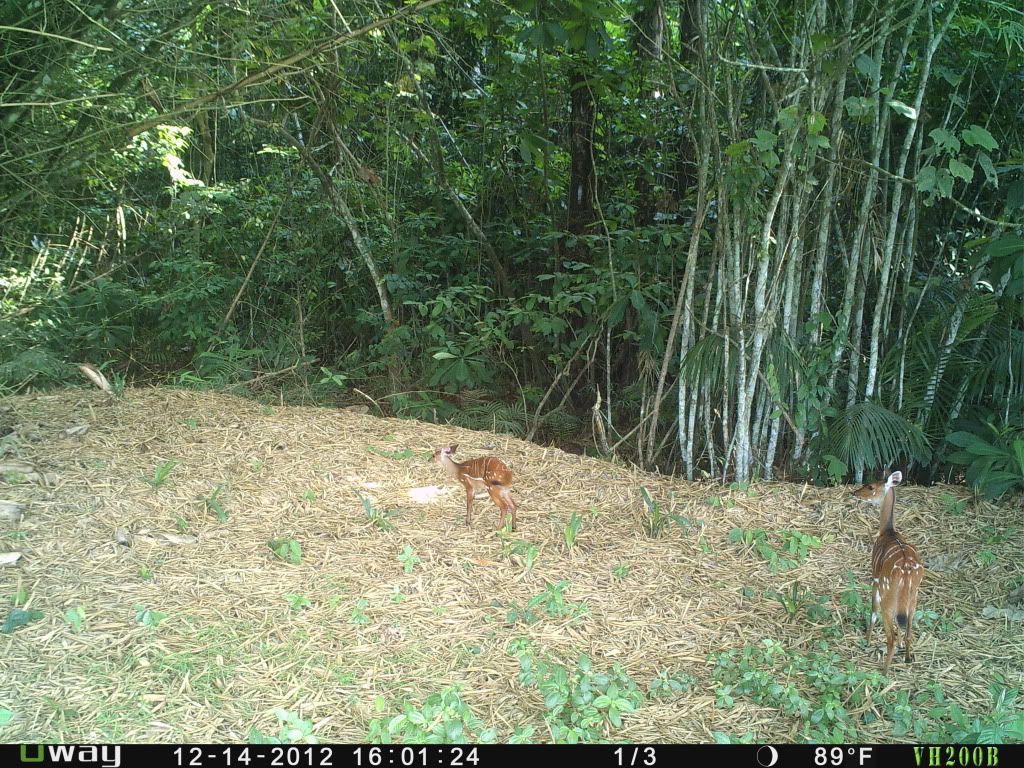
-
Great description of the hunt, Matt. I could almost feel the cold wind in my face, reading about that rainy day stalk.
The landscape where you hunt is picture-postcard beautiful, I must say. Nice shots of the land, and of the quarry. You bagged a fine beast there.
-
Thought I'd add this picture that shows a bit of the swamp forest. The raised embankment on which this fawn stands was built by the dozer digging fish ponds years ago, and is now plastered with antelope tracks, and tore up with horn scrapes. The camera that I set here ten feet up a palm tree is by far the most productive trail-cam I have out there.This is the same spot where the Sitatunga emerges from the swamp, but in the dead of night only.
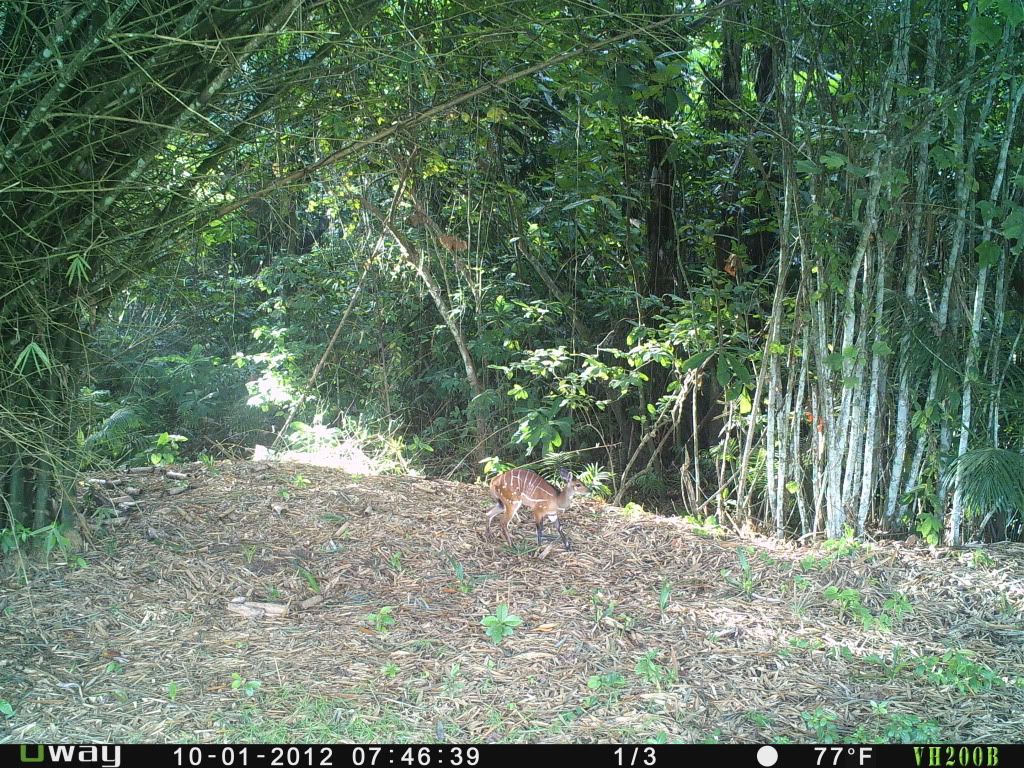 Here
HereHere again is the same Sitatunga using his horns to apply his stamp of authority, to show who's in charge in this area.

-
Thought you fellas might appreicate a few pictures of the species that are hunted here. Don't do much shooting myself these days, seeing as the habitat hs shrunk so much that these species are all pretty much endangered here. Anyways, here goes.
This is about my best closeup of a bushbuck in the wild, as she grazed on the edge of my catfish pond at dawn.

Next is a group shot of my captive herd of bushbuck. I will get around to taking a closeup at feeding time one of these days.
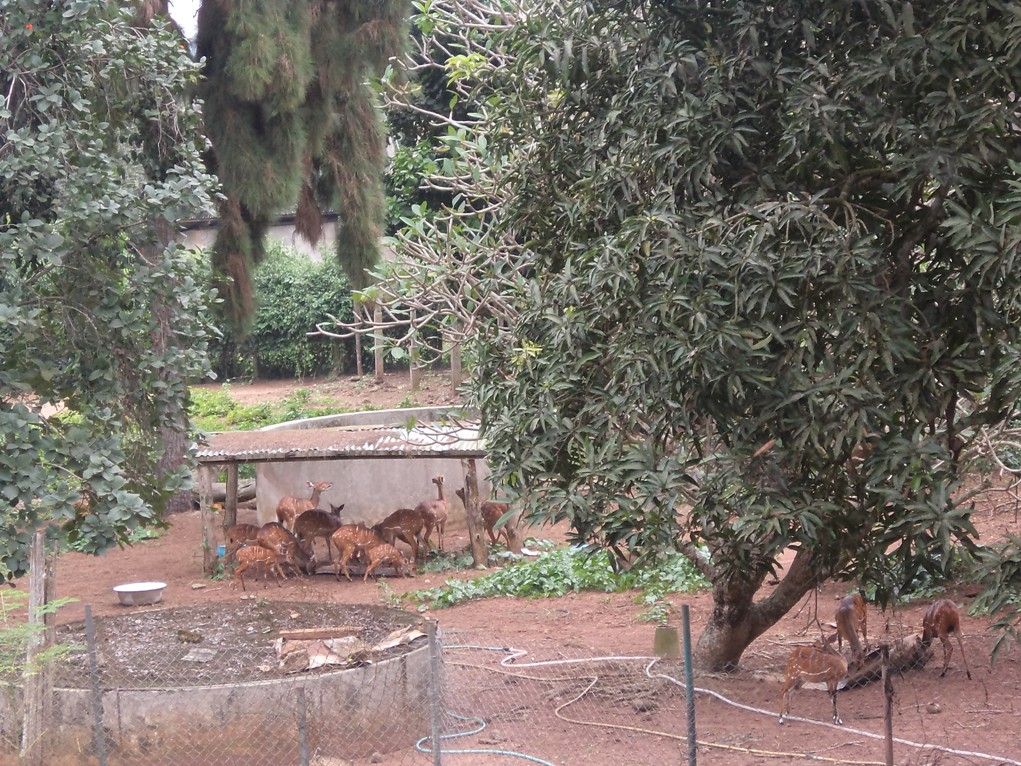
Now this is the King of the Swamp, the Sitatunga swamp antelope, which is as elusive and hard to hunt as any beast out there. This fella is entirely nocturnal, and is very much at home in the swamp where it can submerge like a croc if chased, and simply vanish. He did a dance in front of my trail cam, and clearly winded my scent there, since their sense of smell is second to none.
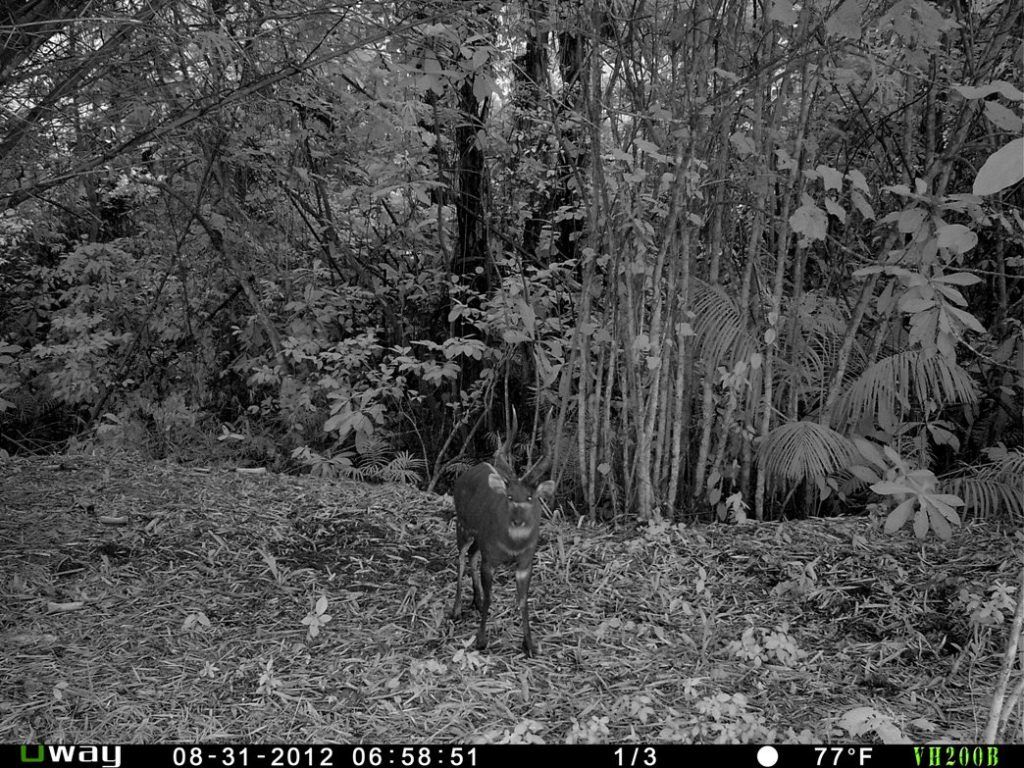
Finally another bush buck male, on an early morning outing.

Hope you hunters like my shots, and I'll post more later as the guests show up.
-
 5
5
-
-
Top notch shooting Foxhunter. That haul should keep the freezer stocked with venisson for a while to come.
-
Years a ago I snared dozens of squirrels, just to learn the technique in case I ever needed it. I used a loop measuring about the size of the circle that you can form with the tip of your middle (ring) finger touching the tim of your thumb, and I generally set them between one and two finger widths above the branch. Depending on the species of squirrel you are after, the size and height of your loop may vary slightly.
Might be an idea to shoot one squirrel to get a close-up view of its head width and approximate head-height above the branch as it runs.
-
It's a Bisam rat or nutria,
A real pest in Germany too.
Imported from north america and set free by activists in Europe.
They are supposed to taste very good and are sold under the name " swamp beaver"
Waidmannsheil!!
As a rule, ALL beaver tastes good, and I speak from personal experience as a muff diver of many years.
-
Pulled this picture of the net. Wikipedia, if I remember rightly.
This is an African pouch rat. and they are being used in some parts of Africa for mine-clearing in areas where brush wars were fought. The rats are too light to set off anti-personnel mines, and they have an acute sense of smell that allows them to detect explosives as accurately as any dog. Trained for that important, life-saving job, these long-snouted little beasties are worth their weight in gold.
-
Right you are about keeping on with the search, PJ. I have spent the day reading consumer reviews on the net, and the Bushnell Trophy Cam Model 119466 CG, sold by Gander Mountain for a rather steep $279 USD each, came out tops.
It costa a good $50 above what I'd hoped to pay, but this nicely camoflagued unit unit is dead silent, produces zero visible light when it flashes for night pictures, and records images of far greater clarity than most other trail cameras in the same price range. Being a creature of habit that I am, staying with a known name brand will probably turn out to be the better choice than settling for some cheaper knock-off,
For anyone interested, here is a link to this trail camera. The camo version is evidently made specially for Gander Mountain, and not available anywhere else.
-
I posted this earlier to day on an electronics forum, but decided to paste a copy here with the hunting community as well, just in case some of the old hands here know of a day/night trail camera with invisible flash, that I could order online. Thanks for any help you can render.
Out on my motorbike on the trials through the woods here, on the trail of a couple of my hounds that took off, I damn near ran over a headless corpse. Talked to some of the locals, and it turns out ritual murder is on the rise, BUT, the cops are too scared to go into the woods. As for crime scene investigation, it doesn't exist in this neck of the woods.
The other "law enforcement" group here comprises civilian volunteers with pump shotguns, and they generally dispense "justice" without recourse to trials of any sort, so I spoke to their head honcho, who also expressed understandable reluctance to go lay in ambush in the woods, especially since the quarry doesn't keep to any fixed schedule.
Then it occurred to me that a number of night vision trail cameras with NO visible flash, positioned overlooking known "dumping grounds" could be the ticket to identify the perpetrators, so that the vigilantes could round up the guilty and dispatch them to the Happy Hunting Ground.
Looking for No-Glow, or "Black Flash" night vision cameras was a bewildering experience, on account of the vast number of makes and models out there. The Chasing Game website seems to have the most comprehensive listing of reviews about the various trail cameras, and that is where my top choice, the Little Acorn 12MP Trail Camera fell from favor, on account of water leakage issues which may or may not have been resolved by the manufacturer.
I am looking to spend no more than $250 USD per camera, and would have preferred to stay with established name brands like Bushnell, so, after long hours of reading looong reviews, I figured there would be no harm asking here if any of you may have hunting experience with No-Glow (Black Flash) trail cameras, where you might have a favorite and reliable model worth mentioning.
I would prefer a woodland camouflage housing, but will make do with camo tape if the preferred model is only shipped in black, and of course I can ONLY use trail cameras that produce NO visible light when they flash for night pictures. Any words of advice would be very much appreciated.
-
the live cams are good would be better to see a terrier working away at him though atb lampy

A Fox-cam and a Terrier-cam would give viewers high-resolution footage from both sides of the canine duel, while aerial footage could also be gathered by a GPS-guided RC quad-copter poised to be scrambled on short notice, for auto-location and auto-hovering above the fox, recording key moments of its life on the run.
-
Got family in the UK, and visit often. Always dreamed of owning a cottage out in the countryside there, but probably never will. To busy hatching catfish out here in Africa.
-
Beautiful part of the country you live in, RH583. City folks don't know what they're missing.
-
Matt and Plastic Jock, I thank you both very much for this vote of confidence in this Chinese ammo. Your assurances do calm my worries, and I will head out to try a few shots in the next couple of days. With rifle ammo so scarce here, I wasn't looking forward to discarding what little I could find to buy, so it is good to hear that panic measure won't be necessary.
Thanks again, fellas, and happy hunting.


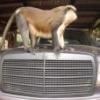
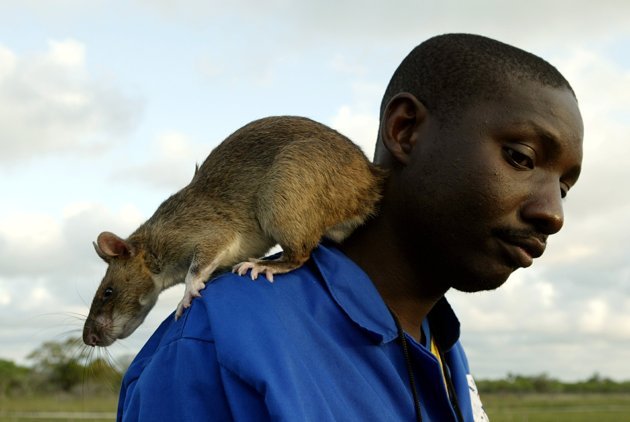
Antelope From the African Swamp
in Deer Stalking & Management
Posted
I've heard of the Wells catfish in Spain's River Ebro, Sniffer. There have been a couple of Discovery Channel programs on those monster Wells, one of which included an interview with a German angler who is credited with illegally introducing Wells into the Ebro River back in the 1970's, by driving over there from Germany in his car, with a few hundred fingerlings that he released into the river.
Hatching here starts at night with a hormonal injection of a Canadian-manufactured drug called Ovaprim, to both parent stock. This is only done in the rainy season from about May to September, when the females are full of eggs. That injection ripens the eggs overnight, and at dawn the eggs are stripped into a bowl. Earlier that morning, the males are slit open, part of the testes is removed, and the opening stitched back, so the testes can re-grow in a year or so.
The testes are slit open and squeezed into the bowl of eggs, which is then swirled about with some water added, to be sure that fertilization has taken place. The eggs are then spread on a mesh in shallow water, where they hatch in another 24 hours, after which they must be graded for size every six days, or, like Wells fry, the big fry will eat the small ones till there are only a handful left.